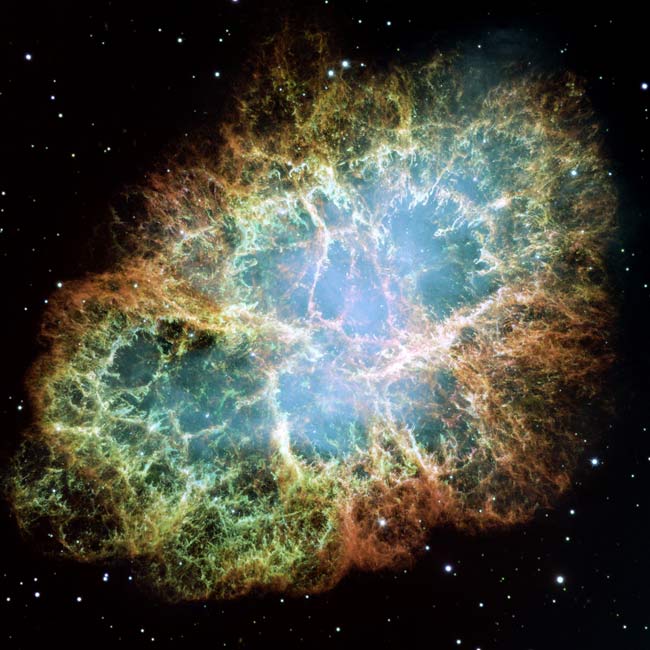Intricate Crab Nebula Poses for Hubble Close-Up

The HubbleSpace Telescope has caught the most detailed view of the Crab Nebula, revealingthe intricate epitaph of a long-dead star.

Astronomersin Japan and China witnessed the birth of the Crab Nebulain 1054, when a star 6,500 light-years from Earth exploded in a brilliantsupernova. [Click here to view animation of the nebula's explosive beginning.]
The nebulaspans a patch of space six light-years across and has proved an attractive targetfor professional and amateur astronomers alike. One light-year is the distancelight travels in one year, about 5.8 trillion miles(9.7 trillion kilometers).
Wispy filaments,primarily of hydrogen, weave through the Crab Nebula, at the center of whichsits a neutronstar that spins 30 times per second.
The onlyfixed remains of the supernova explosion - the rest of the original star stuffhas blown outward - the neutron star acts as a beacon, spitting twin beams ofradiation from its poles as it rotates.
The dense,city-sized object powers the Crab Nebula's bluish glow, which is generated byelectrons that follow the neutron star's magnetic field lines, astronomerssaid. The elemental composition of the nebula can be picked apart by color,with blue areas indicating neutral oxygen, green regions showing singly ionizedsulfur and red portions denoting doubly ionized oxygen, they added.
This imagesuperimposes one of the largest ever produced by Hubble - and the highest resolution viewever of the nebula - over observations from the European Southern Observatory'sVery Large Telescope in Chile. Astronomers used Hubble's Wide Field andPlanetary Camera 2 to build the image.
Breaking space news, the latest updates on rocket launches, skywatching events and more!
- Image Gallery: Hubble Space Telescope's Greatest Hits
- Zoom Into Hubble's Detailed View of the Crab Nebula
- Stunning New View of Energetic Crab Pulsar
- Complete Coverage: The Hubble Space Telescope

Tariq is the award-winning Editor-in-Chief of Space.com and joined the team in 2001. He covers human spaceflight, as well as skywatching and entertainment. He became Space.com's Editor-in-Chief in 2019. Before joining Space.com, Tariq was a staff reporter for The Los Angeles Times covering education and city beats in La Habra, Fullerton and Huntington Beach. He's a recipient of the 2022 Harry Kolcum Award for excellence in space reporting and the 2025 Space Pioneer Award from the National Space Society. He is an Eagle Scout and Space Camp alum with journalism degrees from the USC and NYU. You can find Tariq at Space.com and as the co-host to the This Week In Space podcast on the TWiT network. To see his latest project, you can follow Tariq on Twitter @tariqjmalik.
